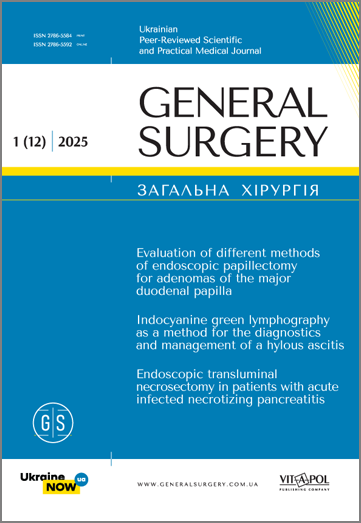Evaluation of different methods of endoscopic papillectomy for adenomas of the major duodenal papilla
DOI:
https://doi.org/10.30978/GS-2025-1-8Keywords:
endoscopic papillectomy, adenoma of the major duodenal papilla, endosonographyAbstract
Objective – to assess the outcomes of endoscopic papillectomy (EP) using standard techniques, as well as to develop and implement novel surgical intervention approaches.
Materials and methods. Between 2021 and 2024, the Department of Interventional Endoscopy at the National Cancer Institute performed EP for adenoma of the major duodenal papilla (MDP) on 19 patients, 10 women (52.63%) and 9 men (47.37%), aged 24 to 78 years, with a mean age of 45.6 years. We observed clinical signs of biliary obstruction and cholangitis in the majority of cases (2 (63.15%)).
Results. 10 patients (52.63%) with tumours <1.0 cm underwent the standard procedure of en‑bloc loop resection (Group 1). To prevent intraoperative and postoperative complications, we developed and implemented a two‑stage EP procedure in 6 (31.57%) cases (Group 2). In 3 (15.78%) patients with tumours ranging from 5.0 to 8.0 cm, the piecemeal approach was used to remove all fragments from the area of the neoplasm that reached into the intestinal lumen (Group 3). After a three‑month follow‑up, 2 patients (10.5%) from Group 3 had a recurrence of an adenoma of the MDP. Both cases required loop diathermy excision for recurrent neoplasms and stent removal. Routine tests at 3 and 6 months revealed no evidence of disease progression.
Conclusions. The topographic and anatomical characteristics of the MDP area determine the complexity of surgical interventions for patients with neoplasms. The novel EP approach minimizes the risks associated with both early and late postoperative complications. The outcomes achieved by employing EP in the treatment of patients with MDP adenomas support its recommendation as the primary approach at specialized centers.
References
Beger HG, Staib L, Schoenberg MH. Ampullectomy for adenoma of the papilla and ampulla of Vater. Langenbecks Arch Surg. 1998;383(2):190-3. https://doi.org/10.1007/s004230050117.
Elek G, Gyôri S, Tóth B, Pap A. Histological evaluation of preoperative biopsies from ampulla vateri. Pathol Oncol Res. 2003;9(1):32-41. https://doi.org/10.1007/BF03033712.
Ito K, Fujita N, Noda Y, Kobayashi G, Horaguchi J, Takasawa O, Obana T. Preoperative evaluation of ampullary neoplasm with EUS and transpapillary intraductal US: a prospective and histopathologically controlled study. Gastrointest Endosc. 2007 Oct;66(4):740-7. http://doi.org/10.1016/j.gie.2007.03.1081. PMID: 17905017.
Itoi T, Tsuji S, Sofuni A, Itokawa F, Kurihara T, Tsuchiya T, Ishii K, Ikeuchi N, Igarashi M, Gotoda T, Moriyasu F. A novel approach emphasizing preoperative margin enhancement of tumor of the major duodenal papilla with narrow-band imaging in comparison to indigo carmine chromoendoscopy (with videos). Gastrointest Endosc. 2009 Jan;69(1):136-41. http://doi.org/10.1016/j.gie.2008.07.036. Epub 2008 Nov 20. PMID: 19026411.
Khashab MA, Acosta RD, Chandrasekhara V, et al. The role of endoscopy in ampullary and duodenal adenomas. Gastrointest Endosc. 2015;82(5):773-81. https://doi.org/10.1016/j.gie.2015.06.027.
Lambert R, Ponchon T, Chavaillon A, Berger F. Laser treatment of tumors of the papilla of Vater. Endoscopy. 1988 Aug;20 Suppl 1:227-31. http://doi.org/10.1055/s-2007-1018181. PMID: 3168951.
Lee R, Huelsen A, Gupta S, Hourigan LF. Endoscopic ampullectomy for non-invasive ampullary lesions: a single-center 10-year retrospective cohort study. Surg Endosc. 2020. (Epub ahead of print) https://doi.org/10.1007/s00464-020-07433-7.
Mendonca EQ, Bernardo WM, Moura EG, Chaves DM, Kondo A, Pu LZ, Baracat FI. Endoscopic versus surgical treatment of ampullary adenomas: a systematic review and meta-analysis. Clinics (Sao Paulo). 2016;71(1):28-35. https://doi.org/10.6061/clinics/2016(01)06.
Spadaccini M, Fugazza A, Frazzoni L, Leo MD, et al. Endoscopic papillectomy for neoplastic ampullary lesions: A systematic review with pooled analysis. United European Gastroenterol J. 2020;8(1):44-51. https://doi.org/10.1177/2050640619868367.
Vanbiervliet G, Strijker M, Arvanitakis M, Aelvoet A, Arnelo U, Beyna T, Busch O, Deprez PH, Kunovsky L, Larghi A, Manes G, Moss A, Napoleon B, Nayar M, Pérez-Cuadrado-Robles E, Seewald S, Barthet M, van Hooft JE. Endoscopic management of ampullary tumors: European Society of Gastrointestinal Endoscopy (ESGE) Guideline. Endoscopy. 2021 Apr;53(4):429-448. http://doi.org/10.1055/a-1397-3198. Epub 2021 Mar 16. PMID: 33728632.
Will U, Bosseckert H, Meyer F. Correlation of endoscopic ultrasonography (EUS) for differential diagnostics between inflammatory and neoplastic lesions of the papilla of Vater and the peripapillary region with results of histologic investigation. Ultraschall Med. 2008 Jun;29(3):275-80. http://doi.org/10.1055/s-2008-1027327. Epub 2008 May 19. PMID: 18491258.
Yasuda I, Kobayashi S, Takahashi K, Nanjo S, Mihara H, Kajiura S, Ando T, Tajiri K, Fujinami H. Management of Remnant or Recurrent Lesions after Endoscopic Papillectomy. Clin Endosc. 2020 Nov;53(6):659-662. http://doi.org/10.5946/ce.2019.171. Epub 2019 Dec 3. PMID: 31794653; PMCID: PMC7719432.
Downloads
Published
How to Cite
Issue
Section
License
Copyright (c) 2025 Authors

This work is licensed under a Creative Commons Attribution-NoDerivatives 4.0 International License.






